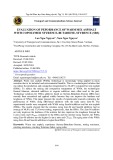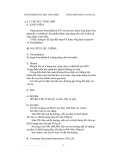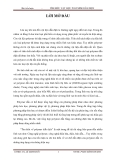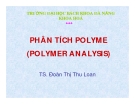
ISSN: 2615-9740
JOURNAL OF TECHNICAL EDUCATION SCIENCE
Ho Chi Minh City University of Technology and Education
Website: https://jte.edu.vn
Email: jte@hcmute.edu.vn
JTE, Volume 19, Special Issue 05, 2024
1
Enzymatic Conversion of Geniposide to Genipin: A Natural Blue Color
Precursor and Biopolymer Film Crosslinker
Thi Nga Vo1, Dac Loc Ho1, Hoang Duc Dang2, Vinh Tien Nguyen1*
1Ho Chi Minh City University of Technology and Education, Vietnam
2Sunrise Global Joint Stock Company, Ho Chi Minh City, Vietnam
*Corresponding author. Email: tiennv@hcmute.edu.vn
ARTICLE INFO
ABSTRACT
Received:
01/05/2024
The research is motivated by the growing interest in using natural products
for biopolymer engineering, particularly in developing bioactive and
biocompatible materials. Genipin, a natural blue colorant precursor, has
garnered attention due to its unique chemical structure and crosslinking
properties with natural polymers. This research focuses on the optimizing
conditions for efficient enzymatic conversion of geniposide from Gardenia
jasminoides into genipin and its subsequent utilization in producing
chitosan-genipin films. Geniposide was extracted using 50% ethanol, and
its enzymatic conversion to genipin using commercial cellulase was best at
pH 4.5, 0.2 g cellulase per gram of geniposide and 6 h of reaction. The
synthesized genipin was used to fabricate chitosan-genipin films, which
were tested for various properties. The film with 0.01 w/w genipin/chitosan
ratio exhibited the highest UV-vis absorbance at 610 nm, indicating
significant crosslinking, and demonstrated the greatest mechanical strength
at 19.92 N/mm². Additionally, this film showed a moisture content of only
2.01%, significantly lower than that of the control. Increasing the amount
of genipin reacting with chitosan significantly reduced the moisture and
swelling degree of the chitosan films, indicating their lower hydrophilicity.
These results underscore the effectiveness of genipin as a crosslinking
agent in biopolymer applications, suggesting its potential to develop
sustainable materials with advanced mechanical and moisture-resistant
properties.
Revised:
19/05/2024
Accepted:
29/05/2024
Published:
28/12/2024
KEYWORDS
Cellulase;
Genipin;
Chitosan-genipin;
Crosslink;
Blue colorant.
Doi: https://doi.org/10.54644/jte.2024.1584
Copyright © JTE. This is an open access article distributed under the terms and conditions of the Creative Commons Attribution-NonCommercial 4.0
International License which permits unrestricted use, distribution, and reproduction in any medium for non-commercial purpose, provided the original work is
properly cited.
1. Introduction
The innovative use of natural products in biopolymer engineering has garnered significant interest in
recent years, particularly in the development of bioactive and biocompatible materials [1]. Genipin, a
natural blue colorant precursor, has gained significant attention in recent years due to its unique chemical
structure and crosslinking properties with natural polymers [2]. It is extracted from various sources,
including Gardenia jasminoides and Genipa americana. Genipin has been recognized for its potential
as a bioactive compound, exhibiting antioxidant, antimicrobial, and anticancer properties. Moreover, it
is considered a non-cytotoxic crosslinking agent, making it suitable for the production of bio-based
materials approved for human contact [3]. The use of genipin in the manufacturing of biopolymers offers
opportunities to enhance the physical and mechanical properties of these materials, making them more
stable and resistant to degradation.
Several methods have been reported for genipin production, including enzymatic hydrolysis,
chemical synthesis, and microbial fermentation. One method of producing genipin involves extracting
it from the fruit of Genipa Americana, also known as genipap or caruto. The fruit's core is used to extract
genipin-rich genipap oil, which can serve as an inexpensive replacement for commercial genipin powder
[4]. This method offers advantages such as high phenolic content, non-hemolytic, antioxidant, and
antimicrobial activity. Microbial fermentation utilizes microorganisms to produce genipin from
geniposide. This method is environmentally friendly and can be performed under mild conditions.

ISSN: 2615-9740
JOURNAL OF TECHNICAL EDUCATION SCIENCE
Ho Chi Minh City University of Technology and Education
Website: https://jte.edu.vn
Email: jte@hcmute.edu.vn
JTE, Volume 19, Special Issue 05, 2024
2
However, it may have lower yields compared to other methods and requires optimization of fermentation
parameters [5].
Enzymatic hydrolysis involves the use of enzymes to break down the precursor geniposide into
genipin. This method offers high selectivity and mild reaction conditions, but it can be time-consuming
and costly [6]. The primary objective of this research is to optimize the conditions for the conversion of
geniposide to genipin using cheap commercial cellulase and to investigate the properties of chitosan-
genipin films under various genipin concentrations. The study aims to establish a scalable and efficient
methodology for producing genipin and to explore its application in fabricating chitosan-based films
with improved physical properties.
2. Materials and Methods
2.1. Extraction and processing of geniposide and genipin
Geniposide extraction: Geniposide was extracted from 10 g of G. jasminoides seed powder using
100 mL of 50% ethanol (EtOH). The mixture was covered to prevent evaporation and stirred at 50°C
for 1 hour. The mixture was then filtered and the filtrate was stored. This extraction process was repeated
three times, pooling the extracts together.
Enzymatic Conversion of geniposide to genipin: The pooled geniposide extract was evaporated to
concentrate the geniposide, which was then treated with cellulase in a citric acid-NaOH buffer across a
pH range of 4.0 to 7.0. Cellulase (0.1 to 0.5 g per 1 g of geniposide) was added to 100 mL of the buffer
containing 0.267 g of geniposide. The reaction was stirred at 50°C for 2 to 10 hours to enzymatically
convert geniposide to genipin.
Genipin Extraction: Genipin was then extracted three times from the hydrolysate using 3×50 mL of
ethyl acetate. The extracts were combined and evaporated to obtain purified genipin.
2.2. Reaction of genipin with amine-containing compounds
The extracted genipin (8 mg) was reacted with different amine-containing compounds
(ethanolamine, glycine, urea, diethanolamine, n-pentylamine, monosodium glutamate - MSG) in a
solution of 50% EtOH at 75°C for 2 to 12 hours. The amine-to-genipin molar ratio ranged from 1 to 3.
Post-reaction, the mixture was dried in a vacuum dryer to yield the pigment powder.
2.3. Chitosan-genipin film formation
A 2% w/v chitosan solution was prepared in a 1% w/v acetic acid containing 0.6% w/v glycerol. An
aqueous solution of genipin was added and the mixture was thoroughly stirred before being poured in
Petri dishes (90 mm diameter) and dried at 40°C for 72 hours to form chitosan-genipin films. These
films were manually peeled and conditioned in a closed chamber with 75% RH at room temperature at
least 2 days before further characterization.
2.4. Colorimetric measurements
The absorption spectra of solutions were recorded using an UH5300 spectrophotometrer (Hitachi,
Japan).
To quantify the color of genipin-based colorants, their aqueous solutions were absorbed on a white
filter paper and the CIE Lab* color space of the colored paper was measured using a Minolta colorimeter
(Konica, Japan). The surface color of chitosan-genipin films was also measured using the same
instrument. Within this color space, the L*-value represents the lightness or luminance of a color,
ranging from 0 (black) to 100 (white). The a*-value indicates the position of the color along the red-
green axis, with positive values representing red and negative values representing green. The b*-value,
on the other hand, represents the position of the color along the yellow-blue axis, with positive values
indicating yellow and negative values indicating blue.
The colorimetric measurements were conducted in triplicate. Statistical analysis was performed using
IBM SPSS Statistics version 20.0. Analysis of variance (ANOVA) with Duncan's multiple range test at
p < 0.05 was carried out to compare the mean values.
3. Results and Discussion

ISSN: 2615-9740
JOURNAL OF TECHNICAL EDUCATION SCIENCE
Ho Chi Minh City University of Technology and Education
Website: https://jte.edu.vn
Email: jte@hcmute.edu.vn
JTE, Volume 19, Special Issue 05, 2024
3
3.1. Factors influencing the hydrolysis of geniposide
3.1.1. pH
Cellulase activity, crucial for geniposide hydrolysis, shows strong pH dependence [7]. While the
enzyme (sourced from Trichoderma reesei) operates between pH 4.5 and 7.5, optimal conditions for
genipin yield were investigated due to side reactions at specific pH levels causing blue product formation
and potential genipin degradation in acidic conditions. Because genipin strongly absorbs 325 nm light,
we used absorbance at this wavelength as the indicator of genipin production [8]. Figure 1 illustrates
variations in blue pigment intensity across a pH range of 4 to 7, with the darkest blue at pH 4.5,
suggesting optimal enzymatic activity and minimal side reactions at this pH.
Figure 1. Gardenia blue solution in different pH of enzymatic reaction.
a)
b)
Figure 2. (a) UV spectra and (b) absorbance at 325 nm of genipin solutions after enzymatic reaction at
different pH conditions.
a)
b)

ISSN: 2615-9740
JOURNAL OF TECHNICAL EDUCATION SCIENCE
Ho Chi Minh City University of Technology and Education
Website: https://jte.edu.vn
Email: jte@hcmute.edu.vn
JTE, Volume 19, Special Issue 05, 2024
4
Figure 3. (a) UV-vis spectra and (b) absorbance at 325 nm of genipin solutions after ethyl acetate extraction
and enzymatic reaction in different pH conditions.
This finding was supported by UV-VIS spectra and color measurements indicating the highest
genipin concentration at pH 4.5 (Figure 2 and Figure 3), corroborated further by color metrics indicating
significant differences in blueness, with pH 4.5 showing the deepest blue tone (Table 1).
Table 1. Color measurement of gardenia blue solutions in different pH of enzymatic reaction.
pH
L value
a value
b value
4.0
61.99±4.28b
-1.03±0.66bc
-2.95±1.79b
4.5
50.14±2.75a
-2.06±0.76abc
-6.12±0.36a
5.0
58.28±3.79b
-0.76±1.63c
-2.75±0.87b
5.5
57.39±3.24b
-3.26±1.47a
-4.03±1.35b
6.0
60.13±6.02b
-2.55±0.44ab
-1.97±1.55b
6.5
61.23±3.03b
-0.56±0.44c
1.2±0.58c
7.0
63.60±3.12b
-0.25±0.26c
1.23±0.33c
Note: different superscript letters in a column illustrate significant differences (p < 0.05).
Therefore, we chose pH 4.5 as the most favorable for genipin production using cellulase [10].
3.1.2. Time
a)
b)
Figure 4. (a) UV-vis spectra and (b) absorbance at 325 mn of genipin solutions after enzymatic reaction at
different times of enzymatic reaction.
a)
b)
Figure 5. (a) UV-vis spectra and (b) absorbance at 325 nm of genipin solutions after ethyl acetate extraction
in different times of enzymatic reaction.

ISSN: 2615-9740
JOURNAL OF TECHNICAL EDUCATION SCIENCE
Ho Chi Minh City University of Technology and Education
Website: https://jte.edu.vn
Email: jte@hcmute.edu.vn
JTE, Volume 19, Special Issue 05, 2024
5
The reaction time profoundly impacts genipin yield, with optimal conditions needing balancing to
enhance efficiency and minimize ineffective durations. Analysis of blue pigment intensity across
varying times (2 to 10 hours) identified 6 hours as potentially optimal, supported by UV-VIS spectra
(Figures 4 and 5). Extended times showed diminishing returns in genipin content, suggesting enzymatic
activity peaks and declines due to substrate depletion [11]. This duration effectively maximizes genipin
yield while minimizing potential losses from prolonged exposure to enzymatic processes and side
reactions.
3.1.3. Enzyme concentration
Enzyme concentration significantly influences the efficiency of the enzymatic hydrolysis of
geniposide. Optimal enzyme usage is crucial for maximizing yield while minimizing waste. Figure 3.10
illustrates variations in blue pigment intensity across different enzyme concentrations ranging from 0.1
to 0.5 g per 1 g of geniposide. The darkest blue observed at 0.1 g suggests this concentration might be
optimal. However, further experiments, including UV-VIS spectra and color measurements, were
conducted for verification.
Figures 6 and 7 display the effects of enzyme concentration on genipin yield. An increase in genipin
was noted from 0.1 to 0.2 g of enzyme per gram of geniposide, followed by a decrease from 0.2 to 0.5
g. The optimal genipin content was observed at 0.2 g, as evidenced by the UV-VIS spectra at 325 nm
and the corresponding absorbance measurements.
a)
b)
Figure 6. (a) UV-vis spectra and (b) absorbance at 325 nm of genipin solutions after enzymatic reaction in
different enzyme concentration.
a)
b)
Figure 7. (a) UV-Vis spectra and (b) absorbance at 325 nm of genipin solution after ethyl acetate extracted in
different enzyme concentration.



![Bài giảng Tính chất cơ lý của vật liệu polymer [chi tiết]](https://cdn.tailieu.vn/images/document/thumbnail/2016/20160304/phamvanphat1891995/135x160/5961457069939.jpg)









![Bài giảng Chế biến khoáng sản vô cơ [Mới nhất]](https://cdn.tailieu.vn/images/document/thumbnail/2025/20251025/thanhvan173002/135x160/21521761538638.jpg)








